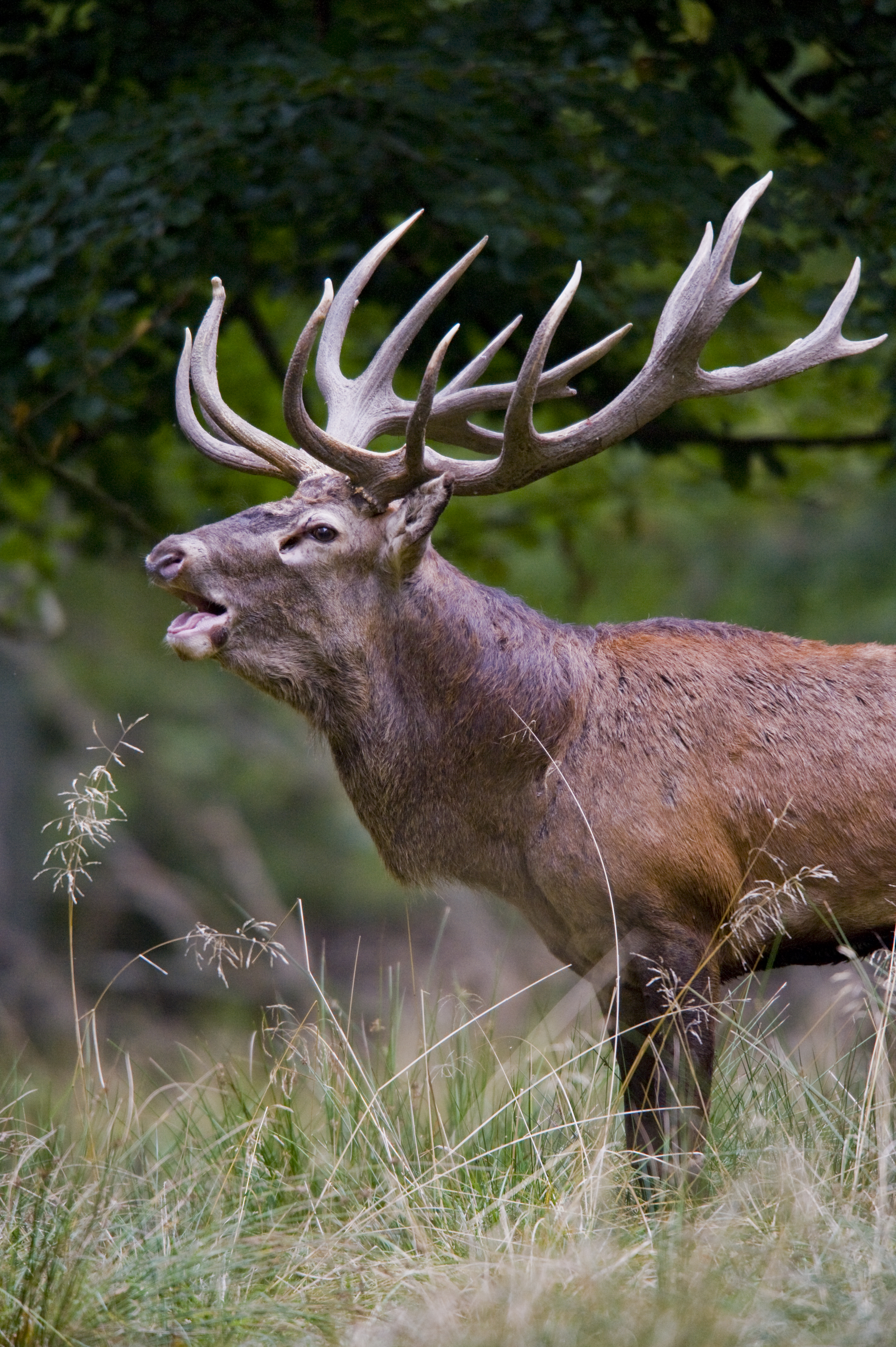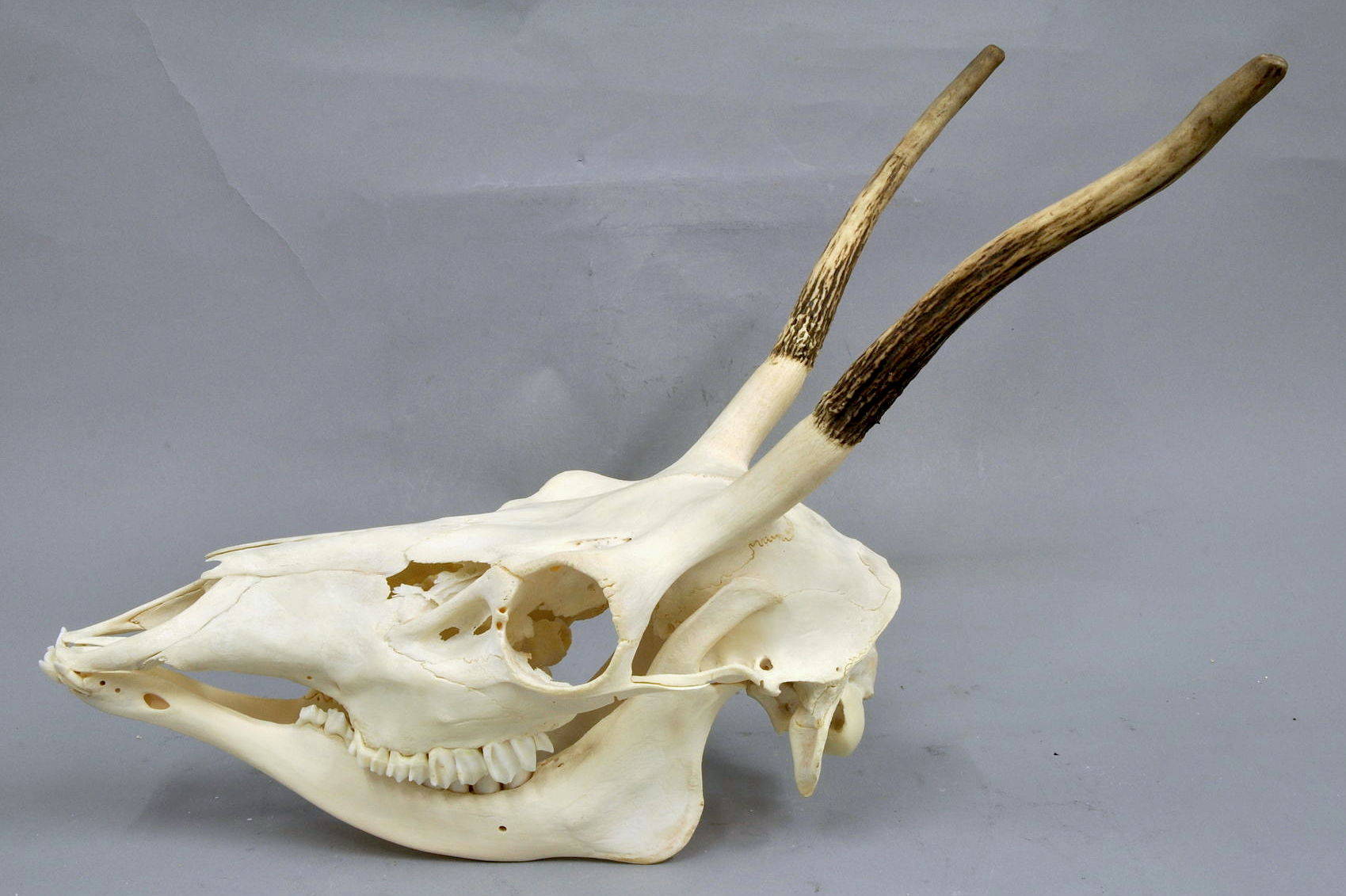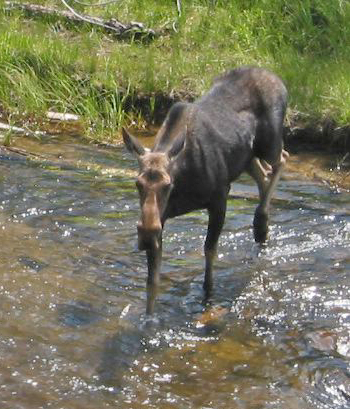|
White-lipped Deer
Thorold's deer (''Cervus albirostris'')Pitraa, Fickela, Meijaard, Groves (2004). ''Evolution and phylogeny of old world deer.'' Molecular Phylogenetics and Evolution 33: 880–895. is a threatened species of deer found in the grassland, shrubland, and forest habitats, at high altitudes, of the eastern Tibetan Plateau, as well as some fragmented areas further north in central Western China. It is also known as the white-lipped deer (or ''baichunlu'', 白唇鹿, in Simplified Chinese, ཤྭ་བ་མཆུ་དཀར།་ in Standard Tibetan) for the white fur around its snout. Thorold's deer is one of the larger ungulate mammals within its range, and fills an ecological niche similar to the Tibetan red deer (or shou, the subspecies ''Cervus elaphus'' ''wallichi'' of the red deer species group). It was first scientifically described by Nikolay Przhevalsky in 1883. As of early 2011, more than 100 of the deer are kept globally in Species360-registered zoos, and, in 1998, it wa ... [...More Info...] [...Related Items...] OR: [Wikipedia] [Google] [Baidu] [Amazon] |
Nikolay Przhevalsky
Nikolay Mikhaylovich Przhevalsky (or Prjevalsky;; , . – ) was a Russian geographer and a renowned explorer of Central and East Asia. Although he never reached his ultimate goal, the city of Lhasa in Tibet, he still travelled through regions then unknown to Westerners, such as northern Tibet (modern Tibet Autonomous Region), Amdo (now Qinghai) and Dzungaria (now northern Xinjiang). He contributed substantially to European knowledge of Central Asian geography. Przhevalsky described several species previously unknown to European science, such as Przewalski's horse, Przewalski's gazelle, and the wild Bactrian camel, all of which are now endangered. He was also a mentor of the explorer Pyotr Kozlov. Biography Przhevalsky was born in the Kimborovo family estate (in the Smolensky Uyezd of the Smolensk Governorate of the Russian Empire) which belonged to his grandfather from his mother's side, a Russian nobleman Aleksei Stepanovich Karetnikov, and his wife Ksenia Davydovna Karet ... [...More Info...] [...Related Items...] OR: [Wikipedia] [Google] [Baidu] [Amazon] |
Chinese Language
Chinese ( or ) is a group of languages spoken natively by the ethnic Han Chinese majority and List of ethnic groups in China, many minority ethnic groups in China, as well as by various communities of the Chinese diaspora. Approximately 1.39 billion people, or 17% of the global population, speak a variety of Chinese as their first language. Chinese languages form the Sinitic languages, Sinitic branch of the Sino-Tibetan language family. The spoken varieties of Chinese are usually considered by native speakers to be dialects of a single language. However, their lack of mutual intelligibility means they are sometimes considered to be separate languages in a Language family, family. Investigation of the historical relationships among the varieties of Chinese is ongoing. Currently, most classifications posit 7 to 13 main regional groups based on phonetic developments from Middle Chinese, of which the most spoken by far is Mandarin Chinese, Mandarin with 66%, or around 800&nb ... [...More Info...] [...Related Items...] OR: [Wikipedia] [Google] [Baidu] [Amazon] |
Provinces Of China
Provinces ( zh, c=省, p=Shěng) are the most numerous type of province-level divisions of China, province-level divisions in the China, People's Republic of China (PRC). There are currently 22 provinces administered by the PRC and one province that is claimed, but not administered, which is Taiwan Province, People's Republic of China, Taiwan, currently administered by the Taiwan, Republic of China (ROC). The local governments of Chinese provinces consists of a Provincial People's Government headed by a Governor (China), governor that acts as the executive, a Provincial People's Congress with legislative powers, and a parallel provincial branch of the Chinese Communist Party (CCP) that elects a Chinese Communist Party Committee Secretary, party secretary and a Chinese Communist Party Provincial Standing Committee, provincial standing committee. Government Provinces are the most common form of province-level governments. The legislative bodies of the provinces are the Prov ... [...More Info...] [...Related Items...] OR: [Wikipedia] [Google] [Baidu] [Amazon] |
Red Blood Cell
Red blood cells (RBCs), referred to as erythrocytes (, with -''cyte'' translated as 'cell' in modern usage) in academia and medical publishing, also known as red cells, erythroid cells, and rarely haematids, are the most common type of blood cell and the vertebrate's principal means of delivering oxygen () to the body tissue (biology), tissues—via blood flow through the circulatory system. Erythrocytes take up oxygen in the lungs, or in fish the gills, and release it into tissues while squeezing through the body's capillary, capillaries. The cytoplasm of a red blood cell is rich in hemoglobin (Hb), an iron-containing biomolecule that can bind oxygen and is responsible for the red color of the cells and the blood. Each human red blood cell contains approximately 270 million hemoglobin molecules. The cell membrane is composed of proteins and lipids, and this structure provides properties essential for physiological Cell (biology), cell function such as erythrocyte deformabil ... [...More Info...] [...Related Items...] OR: [Wikipedia] [Google] [Baidu] [Amazon] |
Physiology
Physiology (; ) is the science, scientific study of function (biology), functions and mechanism (biology), mechanisms in a life, living system. As a branches of science, subdiscipline of biology, physiology focuses on how organisms, organ systems, individual organ (biology), organs, cell (biology), cells, and biomolecules carry out chemistry, chemical and physics, physical functions in a living system. According to the classes of organisms, the field can be divided into clinical physiology, medical physiology, Zoology#Physiology, animal physiology, plant physiology, cell physiology, and comparative physiology. Central to physiological functioning are biophysics, biophysical and biochemical processes, homeostasis, homeostatic control mechanisms, and cell signaling, communication between cells. ''Physiological state'' is the condition of normal function. In contrast, ''pathology, pathological state'' refers to abnormality (behavior), abnormal conditions, including human diseases. ... [...More Info...] [...Related Items...] OR: [Wikipedia] [Google] [Baidu] [Amazon] |
Dewclaw
A dewclaw is a digit – vestigial in some animals – on the foot of many mammals, birds, and reptiles (including some extinct orders, like certain theropods). It commonly grows higher on the leg than the rest of the foot, such that in digitigrade or unguligrade species, it does not make contact with the ground when the animal is standing. The name refers to the dewclaw's alleged tendency to brush dew away from grass.Danziger, D., & McCrum, M. (2008). ''The Thingummy: A book about those everyday objects you just can't name''. London: Doubleday. On dogs and cats, the dewclaws are on the inside of the front legs, similarly to a human's thumb, which shares evolutionary homology. Although many animals have dewclaws, other similar species do not, such as horses, giraffes and the African wild dog. Dogs Dogs almost always have dewclaws on the inside of the front legs and occasionally also on the hind legs. Unlike front dewclaws, rear dewclaws tend to have little bone or m ... [...More Info...] [...Related Items...] OR: [Wikipedia] [Google] [Baidu] [Amazon] |
Preorbital Gland
The preorbital gland is a paired exocrine gland found in many species of artiodactyls, which is homologous to the lacrimal gland found in humans. These glands are trenchlike slits of dark blue to black, nearly bare skin extending from the medial canthus of each eye. They are lined by a combination of sebaceous and sudoriferous glands, and they produce secretions which contain pheromones and other semiochemical compounds. Ungulates frequently deposit these secretions on twigs and grass as a means of communication with other animals. The preorbital gland serves different roles in different species. Pheromone-containing secretions from the preorbital gland may serve to establish an animal's dominance (especially in preparation for breeding), mark its territory, or simply to produce a pleasurable sensation to the animal. Because of its critical role in scent marking, the preorbital gland is usually considered as a type of scent gland. A further function of these glands may be ... [...More Info...] [...Related Items...] OR: [Wikipedia] [Google] [Baidu] [Amazon] |
Metatarsal Gland
The metatarsal bones or metatarsus (: metatarsi) are a group of five long bones in the midfoot, located between the tarsal bones (which form the heel and the ankle) and the phalanges (toes). Lacking individual names, the metatarsal bones are numbered from the medial side (the side of the great toe): the first, second, third, fourth, and fifth metatarsal (often depicted with Roman numerals). The metatarsals are analogous to the metacarpal bones of the hand. The lengths of the metatarsal bones in humans are, in descending order, second, third, fourth, fifth, and first. A bovine hind leg has two metatarsals. Structure The five metatarsals are dorsal convex long bones consisting of a shaft or body, a base (proximally), and a head (distally).Platzer 2004, p. 220 The body is prismoid in form, tapers gradually from the tarsal to the phalangeal extremity, and is curved longitudinally, so as to be concave below, slightly convex above. The base or posterior extremity is wedge-shape ... [...More Info...] [...Related Items...] OR: [Wikipedia] [Google] [Baidu] [Amazon] |
Red Deer
The red deer (''Cervus elaphus'') is one of the largest deer species. A male red deer is called a stag or Hart (deer), hart, and a female is called a doe or hind. The red deer inhabits most of Europe, the Caucasus Mountains region, Anatolia, Iran, and parts of western Asia. It also inhabits the Atlas Mountains of Northern Africa, being the only living species of deer to inhabit Africa. Red deer have been introduced to other areas, including Australia, New Zealand, the United States, Canada, Peru, Uruguay, Chile and Argentina. In many parts of the world, the meat (venison) from red deer is used as a food source. The red deer is a ruminant, characterized by a four-chambered stomach. Genetics, Genetic evidence indicates that the red deer, as traditionally defined, is a species group, rather than a single species, though exactly how many species the group includes remains disputed. The ancestor of the red deer probably originated in central Asia. Although at one time red deer were ... [...More Info...] [...Related Items...] OR: [Wikipedia] [Google] [Baidu] [Amazon] |
Antler
Antlers are extensions of an animal's skull found in members of the Cervidae (deer) Family (biology), family. Antlers are a single structure composed of bone, cartilage, fibrous tissue, skin, nerves, and blood vessels. They are generally found only on males, with the exception of Reindeer, reindeer/caribou. Antlers are Moulting, shed and regrown each year and function primarily as objects of sexual attraction and as Weapon (biology), weapons. Etymology Antler comes from the Old French ''antoillier ''(see present French : "Andouiller", from'' ant-, ''meaning before,'' oeil, ''meaning eye and'' -ier'', a suffix indicating an action or state of being) possibly from some form of an unattested Latin word ''*anteocularis'', "before the eye" (and applied to the word for "branch" or "horn (anatomy), horn"). Structure and development Antlers are unique to cervids. The ancestors of deer had tusks (long upper canine tooth, canine teeth). In most species, antlers appear to replace t ... [...More Info...] [...Related Items...] OR: [Wikipedia] [Google] [Baidu] [Amazon] |
Cervus Albirostris Male
''Cervus'' is a genus of deer that primarily are native to Eurasia, although one species occurs in northern Africa and another in North America. In addition to the species presently placed in this genus, it has included a whole range of other species now commonly placed in other genera. Additionally, the species-level taxonomy is in a state of flux. Taxonomy Genus Until the 1970s, ''Cervus'' also included the members of the genera ''Axis'', '' Dama'', and '' Elaphurus'', and until the late 1980s, it included members of ''Rucervus'' and '' Rusa''. Species In the third edition of ''Mammal Species of the World'' from 2005, only the red deer (''C. elaphus'') and sika deer (''C. nippon'') were recognized as species in the genus ''Cervus''. Genetic and morphological evidence suggest more species should be recognized. For example, the species '' Cervus canadensis'' (elk/wapiti) is considered a separate species. Red deer species group Within the red deer species group, some sources ... [...More Info...] [...Related Items...] OR: [Wikipedia] [Google] [Baidu] [Amazon] |
Moose
The moose (: 'moose'; used in North America) or elk (: 'elk' or 'elks'; used in Eurasia) (''Alces alces'') is the world's tallest, largest and heaviest extant species of deer and the only species in the genus ''Alces''. It is also the tallest, and the second-largest, land animal in North America, falling short only to the American bison in body mass. Most adult male moose have broad, palmate ("open-hand shaped") antlers; other members of the deer family have pointed antlers with a dendritic ("twig-like") configuration. Moose inhabit the circumpolar boreal forests or temperate broadleaf and mixed forests of the Northern Hemisphere, thriving in cooler, temperate areas as well as subarctic climates. Hunting shaped the relationship between moose and humans, both in Eurasia and North America. Prior to the colonial era (around 1600–1700 CE), moose were one of many valuable sources of sustenance for certain tribal groups and First Nations. Hunting and habitat loss hav ... [...More Info...] [...Related Items...] OR: [Wikipedia] [Google] [Baidu] [Amazon] |









